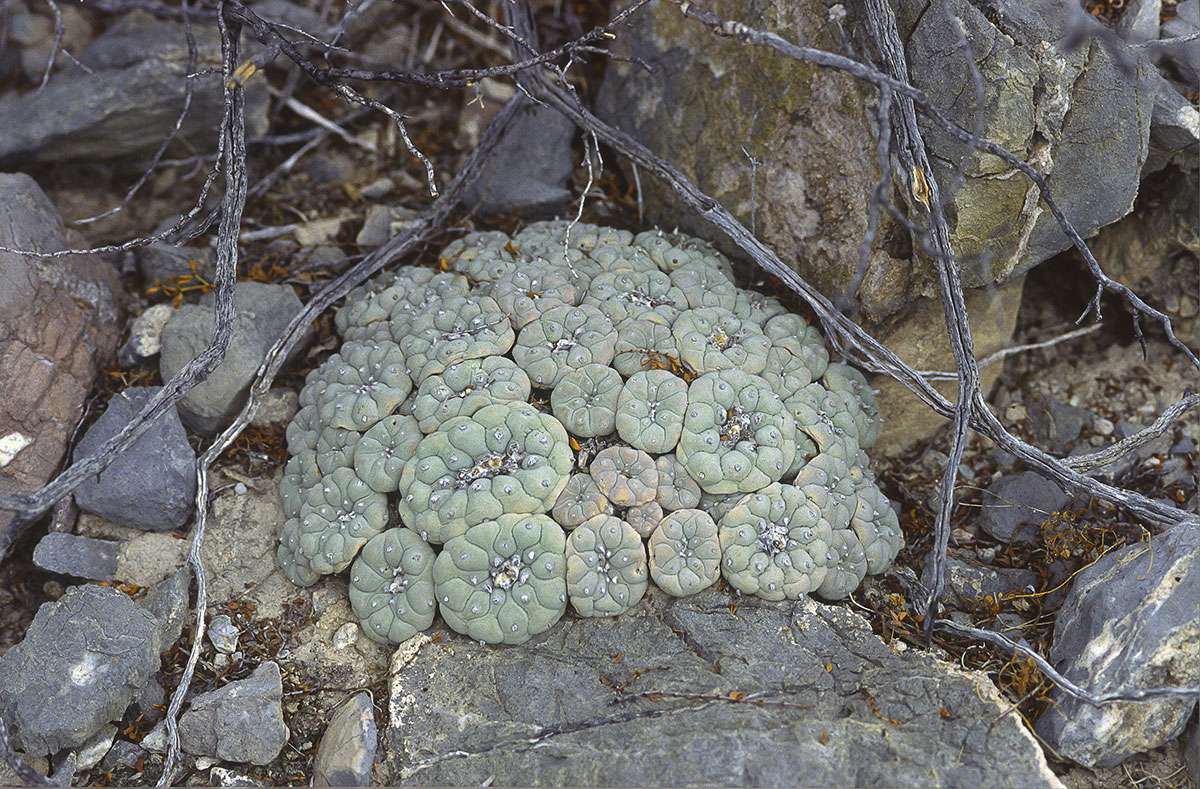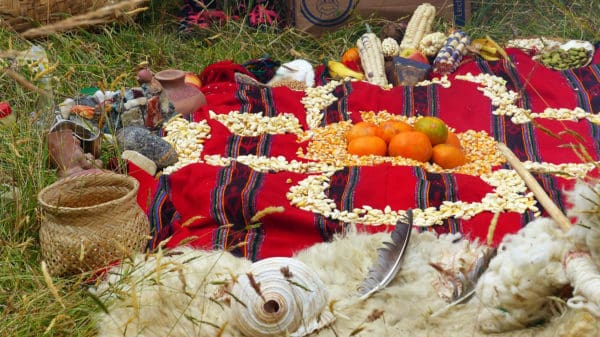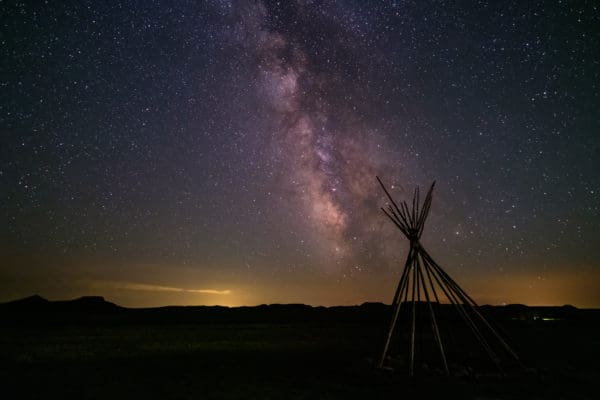Sustainability is typically applied to ecological issues, but it also deals with cultural concerns.
For peyote, sustainability is a conversation about environmental concerns and sustaining the cultures that use peyote as a religious sacrament — namely the Native American Church (NAC). Considering that mescaline derived from peyote inspired the very term psychedelic, there is a natural alliance between supporting psychedelic therapy and supporting peyote conservation efforts.
Without immediate action and intention from beyond the NAC community, there are serious risks of peyote disappearing in the United States. In Texas, where peyote grows within the US, the sacrament is considered to be endangered at the local level. Peyote sustainability is possible, but only if people learn about the ethical issues surrounding peyote and make it a priority to support the people and cultures who steward this medicine.
That being said, any action taken to support peyote sustainability should naturally involve the people who hold it as a protected sacrament. While some traditional psychedelic ceremonies are open to all and invite participants, like San Pedro ceremonies in Peru, the ceremonies of the NAC are explicitly closed to outsiders.
Legally speaking, the NAC was granted an exemption to use peyote on a religious basis after several decades of legal battles. Beyond the NAC, the sacrament remains illegal to use for those who are not members of federally recognized tribes. One cannot simply create their own version of a “native” church in an attempt to bypass this law and gain rights to use peyote. For the NAC, this would be unethical exploitation of a hard-fought right to religious freedom reserved for sovereign nations.
Though the future of wild peyote populations within the United States is uncertain, a bit of discussion and intention can change a lot.
Reciprocity is Not Philanthropy
While researchers and cultural icons began exploring the use of mescaline for creativity and therapy last century, there was no true sense of reciprocity for the original cultures that shared this ancient medicine and healing tradition in the first place.
Reciprocity is different from philanthropy in that it comes from a sense of mutuality, an understanding that “we are in this together”, rather than from an ethic of charity.
Many people who benefit from psychedelics find themselves compelled to “give back” to the cultures that steward the medicine, including but not limited to the Amazonian tribes who steward ayahuasca or the Bwiti of Gabon who steward iboga.
Considering that psychedelic therapy has its roots in the history of peyote and that the NAC is still fighting for sustainable access to their sacrament, it makes sense to direct some of that compulsion toward supporting local Native American tribes as well.
Support can look like getting involved with conservation efforts, advocating for the right for inmates from the NAC to access traditional spiritual ceremonies, or connecting with local Tribal organizations to donate any skills, finances, or labor that might be immediately useful.
But, to demonstrate reciprocity, people people might also work on learning about the occupied land they live upon, the history of broken treaties in the United States, and the United Nations Nagoya Protocol — which is designed to create global frameworks for mutual benefit between indigenous people and the nations that utilize their traditional technologies.
People Who Use Psychedelics Should Support Peyote Sustainability
Peyote has a complex history within psychedelic research and therapy. The complexity arises from the fact that the first psychedelic substance (mescaline) was isolated from peyote back in 1897 when the U.S. government was waging war against Native American tribes and their ways of life
Combined with the fact that the psychedelic counterculture of the 1960s played a role in the overharvesting and illegal poaching of this sacrament, while never stepping in to help support the cultures it directly benefited from, there is already an absence of mutual benefit, or reciprocity.
Though researchers are working to overcome this discrepancy and are currently studying the extent of long-term over-harvesting, the process is expensive, and the federal government does not intervene in the sustainability of Schedule 1 drugs.
In terms of environmental sustainability, it is essential to understand that peyote is critically threatened in Texas, and almost all of the land where the sacrament naturally grows is privately owned.
The idea that chemists, doctors, and psychologists discovered psychedelic healthcare is a common misconception. Western anthropologists learned about psychedelic therapy by observing Native American’s use of peyote, specifically members of the Comanche Tribe who had recently endured forced relocation to Oklahoma. To grasp the concept of cultural sustainability, it’s important to understand the full history.
These facts alone do not tell the whole story. Gaining a deeply rooted understanding of peyote’s complex history might help demonstrate why the both the environmental and cultural sustainability of peyote matters now more than ever.
A peyote Ceremony Inspired the First Synthesized Psychedelic
It’s essential to know and understand the broader story behind the birth of the first synthesized psychedelic — otherwise, the truth will continue to be overlooked.
The roots of the NAC’s sacred tipi ceremony emerged in the 19th century. During that time, Native American tribes were experiencing a horrific genocide and cultural erasure through forced relocations and the elimination of cultural rites, music, and ancestral lands. There are no words that may accurately convey the devastation felt by those who survived these events. And those who did survive often found resilience in the one place the government would not dare to go — inside the tipi.
Before the NAC was established, the sacrament was shared with tribes of the Southwest and Great Plains by guardians of the cactus, the Wixárika, or the Huichol as they are commonly referred to, who reside in the Northern lands of present-day Mexico where peyote grows naturally.
After 40 million bison were exterminated in an effort to starve the tribes, the massacre at Wounded Knee unfolded in 1890 and effectively marked a turning point in the U.S. war against Native Americans. Forcibly removed to reservations in Oklahoma and forced to live off limited Army rations, the peyote ceremony emerged as a therapeutic and unifying communal ritual for Native Americans.
In Oklahoma in 1896, James Mooney, an ethnographer working with the Smithsonian Institute, obtained a bag of the sacred mescaline-containing cacti from a Comanche elder named Quanah Parker. Mooney reported on the ceremony he witnessed, relaying in an article that “the Indians regard the mescal [cacti] as a panacea in medicine, a source of inspiration, and the key which opens to them all the glories of another world.”
Mooney’s observations and the 50-pound bag of sacred cacti prompted Western researchers to take an interest in peyote’s psychoactive effects. One year later, in 1897, a German chemist named Arthur Hefter experimented with the sacred cactus and eventually isolated the psychoactive compound he called meskalin.
As Western researchers experimented further, developing mescaline tinctures and conducting self-experiments, the Native American tribes continued to face legal barriers. In 1912 a federal law was proposed to ban peyote use, but the bill did not clear the Senate because one Oklahoma Senator was persuaded by his constituents to reject it, and he, in turn, convinced his colleagues to pause on the measure.
After this, many anthropologists and leaders united with several Native American tribes to present evidence of peyote’s sacramental use. In 1918 the Native American Church formed and fought several legal battles to protect access to their sacrament — which the government had tried to label as a controlled narcotic despite evidence of traditional use.
According to Western science, the rest of the story is history — psychiatric researcher Humphrey Osmond sat with author and philosopher Aldous Huxley on his first mescaline trip in 1953. Through a series of letters between the two, the word psychedelic — meaning “mind-manifesting” — was officially coined. Meanwhile, members of Native American tribes faced continued poverty and the violent abuse of boarding schools, not to mention continued legal battles to protect their right to use their sacrament. These battles continue today.
Peyote is Threatened by Development and Drug Laws
By the 1960s, psychedelic enthusiasts sought the sacred peyote cactus in droves, leading to overharvesting and poaching in the areas where it grows naturally.
The cactus grows extremely slowly, taking years to reach adulthood and decades to mature to a usable size. If appropriately harvested with roots undamaged, a cactus will produce medicine for decades, even hundreds of years — but poachers are not typically trained in traditional, sustainable harvesting practices.
Peyote is now locally extinct from an ancient grove near Big Bend National Park, where poachers harvested the last cactus only two years ago. In Mexico, the cactus is also facing sustainability issues resulting from drug tourism and illegal poaching. At this point, the NAC can hardly find enough medicine to meet the demands of its pan-tribal membership, estimated as of 2019 to include over 600,000 members.
Some see solutions to the sustainability concern in the form of greenhouses and mass-production. For others, this is a stop-gap measure and an act of desperation, not a long-term solution for the NAC and traditional wisdom holders. They believe that sustainable cultivation could occur — if the cactus were afforded the same level of protection as any other endangered plant.
But because peyote remains classified as a narcotic, landowners are hesitant to lease their private property for the purpose of peyote cultivation, especially when ranching is easier on insurance costs.
Peyote as a Protected Sacrament
There are two concepts related to the term sacrament that can be difficult to translate into the framework of Western scientific research: sacred and sovereign. These terms are occasionally confused with another term more common in the field of psychedelic therapy: cognitive liberty.
While sacred and sovereign convey notions of honor and responsibility, cognitive liberty suggests a more individualized interpretation of morality: that every individual has the right to think as they choose, and thus, the right to alter their consciousness in whatever style they wish — so long as they are not directly harming anyone but themselves in the process.
With this in mind, many people might feel compelled to cultivate peyote for their own use, believing it is an expression of personal liberty and a symbol of solidarity with the NAC and the Religious Freedom Restoration Act.
However, this rationale might be premature and might be considered a form of scientific colonialism — especially if the peyote is used by providers or facilitators who work outside of the NAC. Just because the drug law is unnecessarily restrictive does not mean that peyote’s religious protection is also redundant.
While some might find it difficult to imagine a reality where Native Americans are treated as sovereign nations, it is necessary for non-Native people to practice thinking in this way if they wish to support reciprocity for psychedelic healing.
As an exercise in cultural ethics, consider what the current state of psychedelic research might look like if Native American tribes had been approached ethically when mescaline was “discovered” back in 1897. In this alternative timeline, indigenous people, including the lineage holders in Mexico, would have been present and held as owners and benefactors of their own traditional ecological knowledge (TEK) at every step in the research process.
As Mooney reported after observing the peyote ceremony back in 1896, the knowledge and safe use of mescaline cacti were already clearly established in the oral history of indigenous cultures.
If there were not already an effective protocol in place through ritual and ceremony, Western researchers would never have known the small cactus had any healing potential at all — and the entire story of psychedelic research would have taken on a very different timeline. Mescaline was not isolated from San Pedro until 1960, for example, and there is no reason to assume it would have been discovered any sooner.
Now, imagine if the right to access, grow, and sell peyote had also been protected for the past century. If this had been the case, it is more likely that peyote would not experience a sustainability crisis or face extinction as it does presently. And, it is also likely that the economic health and security of many Native American tribes would be very different than it is today.
In terms of both environmental and cultural sustainability, it might be more important to support Native tribes working to develop their own development programs than to exercise one’s idea of liberty in an effort toward solidarity. This is not to say that growing peyote is unethical (though it can be seen as disrespectful of the NAC), but rather to point out that it is not particularly helpful in addressing peyote sustainability concerns for the 600,000 members of the NAC.
What would be more helpful is demonstrating reciprocity and solidarity for the cause in more direct ways. Offering financial support, donating time, skills, and labor towards lobbying and educational efforts are all important ways of showing up respectfully to support the indigenous peoples of the United States and Mexico whose very cultures and ways of life are impacted by issues of peyote sustainability.
A Final Thought: peyote is an ancient medicine with a long history of ceremonial use. It has grown in the same ranges for millennia. Despite its status as a federally protected religious sacrament, in the past 50 years, peyote has been overharvested and poached to the point where it may become extinct in the wild. Such a tragedy is avoidable so long as people and providers make commitments to work respectfully with Native American tribes to support an ethical, sustainable, and sovereign peyote market for members of the NAC.









